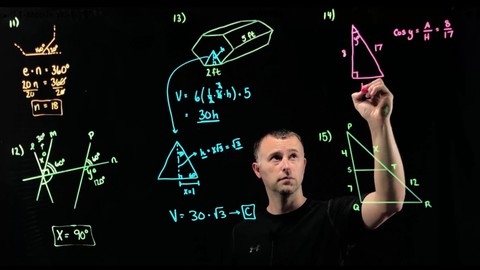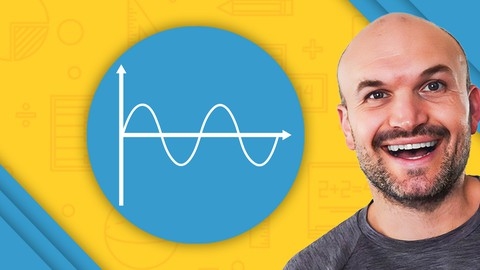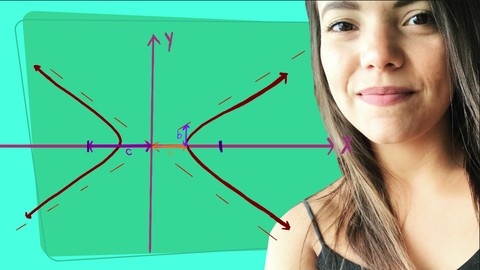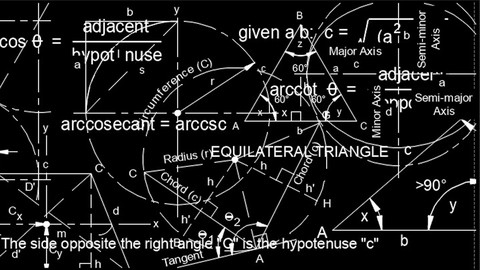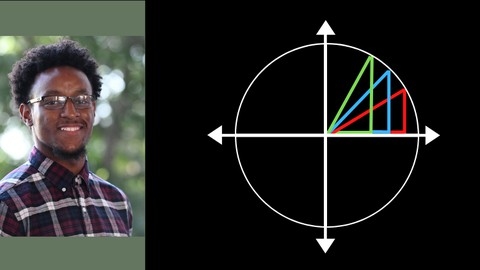Pre-calculus is the bridge between basic algebra and the more advanced concepts of calculus.
It builds upon fundamental mathematical principles, introducing topics like trigonometry, functions, and sequences, which are essential for understanding calculus and other higher-level math courses.
Mastering pre-calculus equips you with a solid foundation for success in STEM fields, enabling you to solve complex problems and delve into fascinating areas like physics, engineering, and computer science.
Finding a suitable pre-calculus course on Udemy can be a daunting task.
There are numerous courses available, each with its own approach, focus, and level of difficulty.
You want a program that’s comprehensive, engaging, and taught by experienced instructors, yet aligns with your learning style and goals.
For the best pre-calculus course overall on Udemy, we recommend Perfect Your Mathematical Skills (Pre-Calculus Course).
This program is a comprehensive guide that covers a wide range of pre-calculus topics with in-depth explanations, practice exercises, and downloadable resources.
The instructor breaks down complex concepts into manageable chunks, making the learning process clear and engaging.
With this course, you’ll gain a firm grasp of pre-calculus concepts and feel well-prepared for college-level calculus.
While Perfect Your Mathematical Skills (Pre-Calculus Course) is our top pick, there are other excellent pre-calculus courses available on Udemy.
Keep reading to explore our recommendations for different learning styles, budgets, and specific areas of pre-calculus you want to focus on.
We’ll help you find the perfect course to jumpstart your journey into the world of advanced mathematics.
Perfect Your Mathematical Skills (Pre-Calculus Course)
You’ll start with a strong foundation in integers, directed numbers, and divisibility rules, ensuring you have a solid grasp of the fundamentals.
From there, the course dives into rational and irrational numbers, equipping you with the skills to work with fractions, decimals, and irrational expressions.
You’ll also learn about indices (exponents) and logarithms, which are crucial concepts for advanced mathematics.
The course dedicates significant time to geometry, covering lines, angles, polygons, and triangles.
You’ll learn about parallel lines, angle properties, and how to solve problems involving these shapes.
Coordinate geometry is also covered in-depth, including the distance formula, midpoint formula, and graphing equations.
Sequences and series are essential topics in pre-calculus, and this course covers both arithmetic and geometric progressions.
You’ll learn to find the general term, sum of terms, and solve related problems.
Functions are a core concept, and the course teaches you how to identify, graph, and work with different types of functions, including composite and inverse functions.
You’ll also learn about domain, range, and the vertical line test.
Finally, the binomial theorem is covered, allowing you to expand binomial expressions and find specific terms or coefficients.
Throughout the course, you’ll have access to practice problems, past paper questions, and downloadable resources to reinforce your understanding.
Pre-Calculus Video Series
This course covers a comprehensive range of topics to prepare you for the challenges of calculus.
You’ll start by reviewing fundamental algebra skills like factoring, simplifying rational expressions, and working with exponents and functions.
This lays a solid foundation for the more advanced concepts to come.
From there, the course dives into polynomial and rational functions, teaching you how to graph them, find their zeros, and divide polynomials.
You’ll also learn about exponential and logarithmic functions, which are crucial for understanding calculus concepts like limits and derivatives.
The units on conic sections and trigonometry are particularly valuable.
You’ll study circles, ellipses, hyperbolas, and parabolas, as well as right triangle trigonometry and graphing trig functions.
These topics are essential for many calculus applications.
But it doesn’t stop at trigonometry.
The course also covers vectors, complex numbers, polar coordinates, and even a preview of limits to get you ready for calculus.
You’ll learn about sequences, series, the binomial theorem, and mathematical induction too.
What’s really impressive is the depth the course goes into.
You’ll not only learn the core concepts but also explore partial fractions, trigonometric identities and equations, and applications of the laws of sines and cosines.
This level of preparation will give you a significant advantage in your calculus course.
You’ll gain mastery over a wide range of mathematical topics, setting you up for success in your future studies.
Pre-Calculus from Beginner to Advanced 2024
The course covers a wide range of topics that will prepare you for calculus, including coordinate geometry, straight lines, functions, and transformations.
One of the standout features of the course is its comprehensive coverage of coordinate geometry and straight lines.
You’ll learn about the coordinate system, how to find the length of a line segment, and how to calculate the midpoint of a line segment.
The course also covers the equation of a straight line, including different forms of linear equations and how to find the gradient.
Another key topic is functions, graphs, and transformations.
You’ll learn about common functions like straight lines and how to graph them.
The course also covers important concepts like asymptotes and limits, which are essential for understanding calculus.
Additionally, you’ll learn about various transformations, such as translations (both vertical and horizontal shifts), stretching, compression, and reflections about the x-axis and y-axis.
The course includes plenty of examples and exercises to reinforce your understanding of the concepts.
There are also activities designed to help you memorize important graphs and practice transformations.
One of the strengths of this course is its focus on parallel and perpendicular lines, which are crucial for understanding geometry and calculus.
You’ll learn how to identify and work with parallel and perpendicular lines, as well as how to find the intersection of two lines.
Pre-Calculus Simplified
You’ll start by learning about functions, including their characteristics, implied domains, transformations, piecewise functions, operations, and inverses.
This foundational knowledge will be essential for understanding more advanced concepts.
Next, you’ll dive into polynomials, exploring their characteristics, binomial expansion, and finding real, rational, irrational, and complex zeros.
This will give you the tools to work with polynomial equations and expressions.
Rational functions are up next, where you’ll learn how to simplify rational expressions, graph rational functions, and solve rational equations.
This is a crucial skill for dealing with fractions and ratios in calculus.
Trigonometry is a significant part of the course, covering right triangle trigonometry, angles, the unit circle, graphing trigonometric functions and their reciprocals, and inverses.
You’ll also learn about analytic trigonometry, simplifying identities, verifying identities, and solving trigonometric equations, as well as sum, difference, double, and half-angle formulas.
The applications of trigonometry are also covered, including solving word problems, the laws of sines and cosines, vectors on a plane, applications of vectors, parametric equations, and polar equations.
These topics will help you apply trigonometry to real-world scenarios.
Conic sections, such as parabolas, ellipses, and hyperbolas, are explored in depth, giving you the ability to classify and work with these important curves.
Finally, you’ll learn about limits, a fundamental concept in calculus.
This includes continuity, general limits, left and right-hand limits, and limits at infinity, preparing you for the study of derivatives and integrals.
Pre-Calculus EVERYTHING Explained
This course is a comprehensive pre-calculus program that covers a wide range of topics essential for success in calculus and higher-level mathematics.
You’ll start by diving into trigonometry, mastering the six trigonometric ratios, the unit circle, and inverse trigonometric functions through numerous exercises.
This lays a solid foundation for working with angles and periodic phenomena.
Next, you’ll explore polynomials in-depth, from basic operations like addition and multiplication to more advanced techniques like factorization using various methods.
You’ll also learn to solve quadratic equations using multiple approaches, including the quadratic formula and synthetic division.
The course then shifts gears to functions, a core concept in calculus.
You’ll learn about different function types, transformations, domains, ranges, and operations like composition and finding inverses.
Vectors and matrices are covered as well, equipping you with tools for linear algebra.
Conic sections like circles, parabolas, ellipses, and hyperbolas are explored thoroughly, with a focus on deriving their equations and graphing.
Sequences, series, and probability lay the groundwork for discrete mathematics.
Finally, you’ll venture into the fascinating realm of imaginary and complex numbers, mastering operations, graphing on the complex plane, and applying concepts like Euler’s formula.
Throughout, you’ll encounter a wealth of exercises that reinforce concepts and prepare you for calculus.
Mr. Sutton Presents… Pre-Calculus Honors
You’ll start by mastering quadratics, learning different methods to solve them, including factoring, completing the square, and using the quadratic formula.
From there, you’ll dive into polynomials, exploring techniques like synthetic division, the rational roots theorem, and graphing polynomials in different forms.
You’ll also learn about binomial expansion and applications of polynomials.
Rational functions are next, where you’ll simplify, multiply, divide, add, and subtract rational expressions.
You’ll tackle complex fractions, rational equations, and graph rational functions, too.
The course then moves on to exponential and logarithmic functions, covering compound interest, laws of logarithms, and solving exponential and logarithmic equations.
You’ll also explore applications of these concepts.
Trigonometry is a major component, covering right triangle trigonometry, the laws of sines and cosines, trigonometric identities like double angle formulas, and solving trig equations.
You’ll learn about polar coordinates and vectors, including graphing in polar form and vector applications.
The course also covers conics like circles, ellipses, and hyperbolas, as well as parametric equations.
Finally, you’ll study sequences and series, arithmetic and geometric sequences, infinite geometric series, and concepts like convergence.
With practice quizzes throughout, this course ensures you’ll be fully prepared for calculus after mastering these pre-calculus topics.
Pre-AP Pre-Calculus
You will start by exploring function properties, including even and odd functions, piecewise functions, transformations, and inverse functions.
This lays the foundation for understanding more complex functions later on.
Next, you’ll dive into polynomial theorems, learning about end behavior, zeroes, multiplicity, division, and the rational root theorem.
This unit also covers rational functions and inequalities involving polynomials and rational functions.
The course then moves on to exponential and logarithmic functions, teaching you how to graph, model, solve equations, and apply properties of these functions.
This is a crucial topic for calculus.
Trigonometry is a significant focus, with units dedicated to angles, the unit circle, right triangle trigonometry, graphing sine, cosine, and other trig functions with transformations, and applications like arc length and angular/linear speed.
You’ll also learn to solve right triangle problems, work with bearings and nautical miles, and study inverse trig functions and their graphs.
Trigonometric identities, solving trig equations, sum and difference formulas, double and half angle formulas, and the laws of sines and cosines are covered in depth.
Vector operations, dot products, parametric equations (including graphing and solving), and polar graphs are explored to prepare you for calculus.
The course concludes with a study of conics (circles, parabolas, ellipses, and hyperbolas), binomial expansion using Pascal’s triangle, sequences (arithmetic and geometric), series, and summation notation.
Pre-Calculus & Trigonometry: Meet The Unit Circle
You’ll start by learning about the structure of the unit circle, including its quadrants and how to color them correctly.
Next, you’ll dive into angles and their relationship with the unit circle.
You’ll practice filling in the blanks to solidify your understanding of angles on the unit circle.
The course then shifts its focus to coordinate values.
You’ll learn how to find the x- and y-coordinates of points on the unit circle and practice filling in the blanks to reinforce this skill.
Right angles are another crucial topic covered in the course.
You’ll explore how right angles relate to the unit circle and their corresponding coordinate values.
Multiple practice exercises will help you cement your knowledge of right angles and their coordinate values on the unit circle.
Throughout the course, you’ll have access to downloadable documents and get to know your tutor, ensuring a personalized and supportive learning experience.
Pre Calculus 12 BC Test Prep.
You’ll start by mastering transformations of functions, including detailed solutions to practice problems.
Next, you’ll dive into polynomials and rational functions, working through numerous examples to solidify your understanding.
The course then focuses on composite functions, providing ample practice questions and step-by-step solutions.
You’ll also explore trigonometry, both circular functions and trigonometric identities, with a wealth of practice problems to reinforce your skills.
Logarithms and exponents are covered in-depth, ensuring you have a strong grasp of these essential concepts.
The course concludes with a section on combinatorics, guiding you through intricate problems and their solutions.
Throughout the course, you’ll encounter a vast array of practice questions accompanied by detailed solutions.
Become a Trigonometry & Precalculus Master
You’ll start by learning the fundamentals of angles, including naming, measuring, and classifying them.
Then, you’ll dive into the six trigonometric functions, their properties, and how to use them to solve right triangles.
The course takes you through the unit circle, which is essential for understanding the behavior of trigonometric functions.
You’ll learn how to graph these functions, apply transformations, and work with their inverses.
Trigonometric identities are also covered in detail, equipping you with powerful tools for simplifying expressions and solving equations.
Moving on to Precalculus, you’ll explore polar coordinates and curves, a different way of representing points and equations.
Complex numbers are introduced, and you’ll learn how to perform operations with them and solve complex equations.
Matrices are a crucial topic, and you’ll learn how to represent systems with matrices, perform operations like addition and multiplication, and use techniques like Gauss-Jordan elimination and Cramer’s Rule to solve systems of equations.
The course also covers partial fractions, an important technique for integrating rational functions.
You’ll learn how to decompose fractions into simpler terms, which is useful in calculus and differential equations.
Conic sections, including circles, ellipses, parabolas, and hyperbolas, are studied in detail, both in rectangular and polar coordinates.
This lays the foundation for understanding these curves in calculus and physics.
Finally, you’ll learn about parametric curves, which are useful for representing motion and modeling real-world phenomena.
You’ll learn how to eliminate the parameter and find the parametric representation of curves.
Throughout the course, you’ll have access to quizzes, practice problems, and formula sheets to reinforce your understanding.


